Madison Barracks, Jefferson County, New York
Description and photos from a visit by M. Stone in June, 1994.
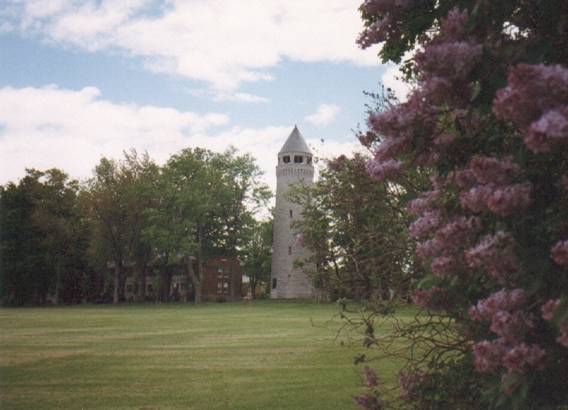
The old
Parade Grounds at Madison Barracks, when the lilacs are in bloom.
The distinctive water tower wasn’t constructed until 1892.
The following is an interesting excerpt from a typewritten manuscript I found in 1995 at the National Archives entitled “A Brief History of Madison Barracks” [NARA RG 393, Entry 12, Box 3]. It gives some details of what life at Madison Barracks was like during the period following the Civil War, when my great-great-grandfather, Lewis H. Roberts, served there as a member of the V.R.C. (Veterans Reserve Corps, June 1867 to April 1869). His future wife, Ellen Roberts, lived in nearby Sackets Harbor and worked at the “Camp home” (hospital? home for disabled soldiers?) at Madison Barracks around that time, which is how they met. They were married 10 August 1868.
March 25th 1867 the detachments of the 4th and 16th Inf. were relieved by 2nd Lt. A.C. Payne [Andrew C. Bayne?] 42nd U.S. Inf. Bvt. Maj. Tully McCrea, Capt. Co. C 42nd U.S. Inf’y commanded the Post from April 15th 1867 (Veteran Reserve Corps) with Co. “C” of that regiment till April 1867, 29th when Bvt. Maj. General J.B. McIntosh 42nd Inf. (V.R.C.) assumed command and transferred the Headquarters of his regiment from Plattsburg Barracks to this place, where it remained till April 13th 1869, when his regiment took its departure for Fort Gibson C.N. [in Indiana] to be concolidated [sic] with the 6th U.S. Inf.
The 42nd U.S. Inf. (V.R.C.) was ordered to be organized by Gen. Meade in accordance with instructions of the Secretary of War, in Nov. 1866, for service in the Dep’t of the east. The men composing it were in the language of order, “to be none but men who have been wounded in the line of their duty while serving in the Army of the United States, and who were found on Medical examination not unfitted for garrison or other light duties.” At first none but wounded men were taken, but afterwards men with chronic diarrhoea [sic] were received. Most of the men of this regiment were examined in New York by the writer and special reports of each were made, showing the anatomical location of the wounds, or operations had been performed in the case [sic], the condition of the parts at the time of the examination, and the effect that had been produced upon the mens [sic] health or the usefulness of their limbs, by the injuries received. Care was taken to exclude all men whose injuries prevented them from comming [sic] within the spirit of the order forming the regiment yet the ratio of sickness in the command was large (11-1/2 percent) for while the men presented a general apperance [sic] of health, there were but few of them whose constitutions were not shattered to the very foundation, by the overstraining exertions, fatigues, exposures and privations, to which they had been subjected in their service during the rebellion. Most of them were upset by even slight physical exercise and some of them would be laid up for a week after every tour of guard. The wet weather of spring and fall brought out their old rheumatisms and the low temperature of winter effected [sic] their wounds with neuraliga [sic]. From the organization to its dissolution, two years and two months, 10-9/10 percent of all the diseases in the regiment were cases of chronic rheumatism and 10-9/100 [sic] per cent, were cases of neuralgia. Six of these men were during the above period sent to the government Insane Asylum.
Neuraliga [sic] was a peculiar and bitter legacy left to the wounded men of this regiment, and it characterized many of them as pitiable sufferers. Some of them had their attacks of pain at regular short intervals, others had theirs at long intervals; some had but little pain, while others suffered the torment of an agony that found no relief short of the anesthesia of chloroform. Some of the slightest wounds seemed to be the cause of the severest pain. Sharp cold weather, or chilly damp weather always brought on the attacks of pain in the majority of cases.
Nothing further seems called for in this place, concerning this disease than a few words about the treatment that was adopted. Every variety of local emodyne applications in the form of vintments, plasters Etc. were used to allay the pain with only a temporary benefit. In some cases the application to the seat of pain, which was often remote from the pain for a long time; occasionally in light cases, a cure was effected in this way; but the remedy that came to be relied on, as the one that afforded the greatest relief from pain, and as giving the best chance for perment [sic] relief, was the hypodermic application of sulph morphia. This was the main of dependence, and could always be relied upon for almost entire and immediate relief from the pain. During my service with this regiment not less than three thousand of these injections were given and in no instance were they followed by absess, inflammation, erysipelas, or trouble of any kind. Some few of the cases that appeared to have a malarious impression were treated sucessfully [sic] by quinine. But the unfortunate feature of this dreadful condition, is its tendency to recur from slight exposure to the weather, and perhaps a long absence, and it is a sad reflection, that the majority of these men will pass through life, without the possibility of any permanent relief from their pain.
While General McIntosh was in command about $25,000 worth of repairs and painting were put upon the Barracks.
The officers of the 42nd Inf. who followed Gen. McIntosh in command as follows:
Major T.F. Rodenbaugh 42nd Inf. from Dec. 12, 1867 to May 26, 1868
Bvt. Maj. C.T. Greene 42nd Inf. from May 26, 1868 to June 3, 1868
Maj. F.T. Rodenbaugh 42nd Inf. from June 7, 1868 to Aug. 20, 1868
Bvt. Maj. C.T. Greene 42nd Inf. from Aug. 20, 1868 to Oct. 5, 1868
Maj. T.F. Rodenbaugh 42nd Inf. from Oct. 5, 1868 to Feb. 16, 1869
Bvt. Maj. C.T. Greene 42nd Inf. from Feb. 16, 1869 to Mar. 5, 1869
Bvt. Brig. Gen. T.F. Rodenbaugh 42nd Inf. from Mar. 5, 1869 to Apr. 13, 1869...
During the winter of 1868, the men of the 42nd Inf. converted one of the ordnance sheds into a respectable theater capable of holding two hundred people, and it was always filled. The entertainments were of the negro minstrel, and varieties order and certain parts were done in a truly professional style.
During the summer of 1869, the hospital grounds were enclosed by a substantial picket fence, and efforts were made to restore the paths and shrubbery.
A new magazine was constructed chiefly of the bricks of an old one that was built for use in Fort Pike in 1812. Four sets of laundresses quarters were built of wood; the stable almost rebuilt, and windows were put in the blind wall of the eastern set of mens quarters to light the squad rooms, dining room and kitchens.
The Post Burial Ground was surrounded by a new wood picket fence in 1868, and the graves have been registered and marked by headboards where ever they could be identified, and the remainder were re-sodded. Among the five hundred and seventy-six (576) graves found in this place, only twenty-nine (29) are marked by head stones or boards and these consist chiefly of the members of officers and soldiers [sic] families interred from 1813 to 1867.
Eauur Vollum
Surgeon U.S.A.
April 1870
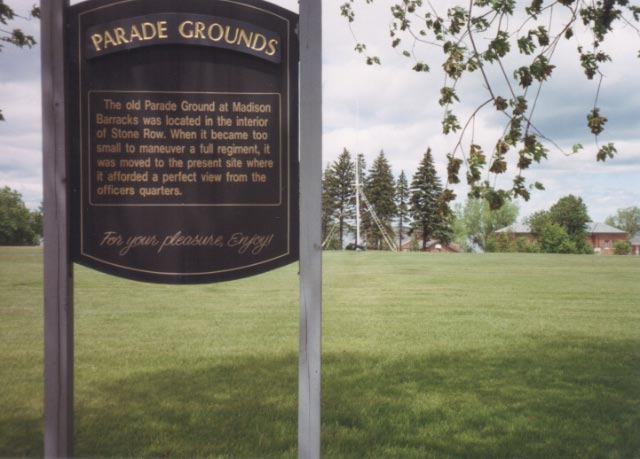
Sign reads: “The old Parade Ground
at Madison Barracks was located in
the interior of Stone Row. When it became too small to maneuver a full
regiment, it was moved to the present site where it afforded a perfect view
from the officers’ quarters. For your pleasure, Enjoy!”
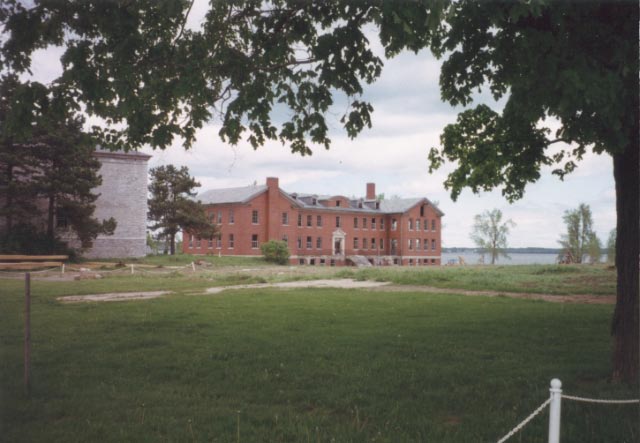
Old abandoned building (formerly Barracks B?). Next to it (grey stone) is the
former hospital building, built in 1838.
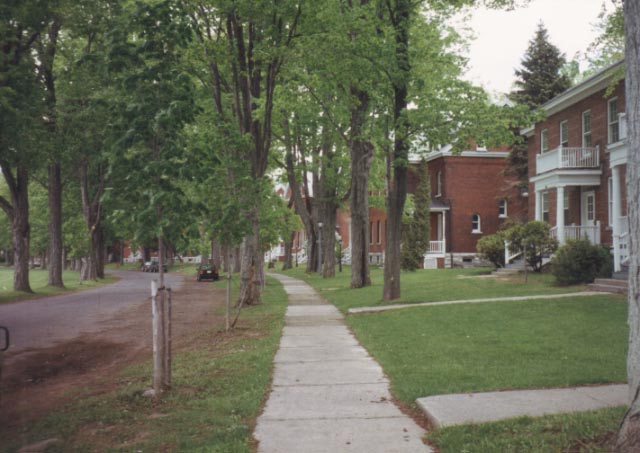
Formerly Officers’ Row, these dwellings are now private residences.
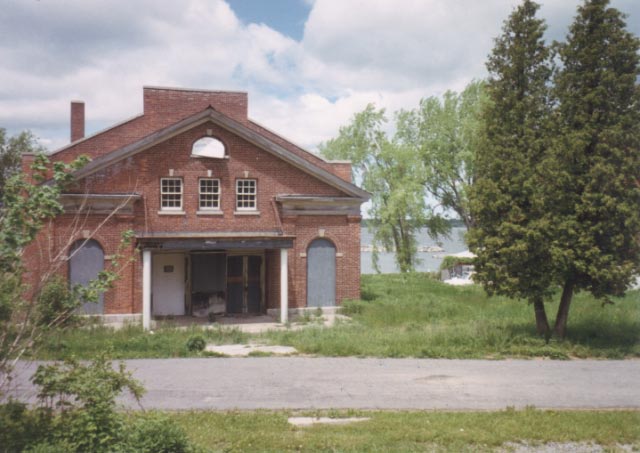
Another abandoned old building--the former theater built in 1932.
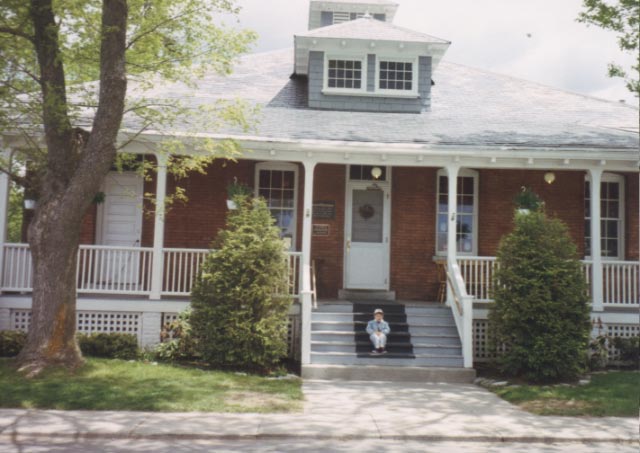
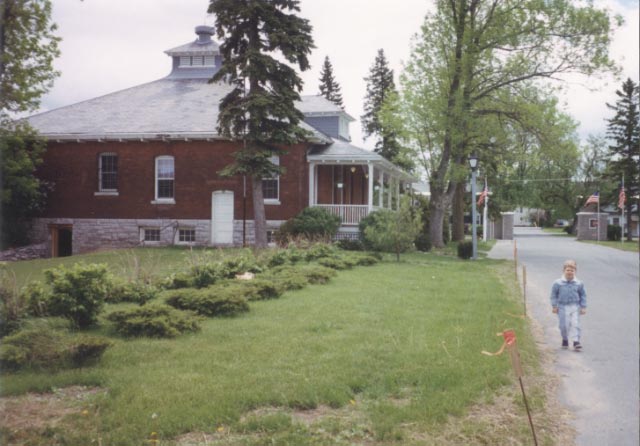
Two views of the former guardhouse built in 1897, now an administration headquarters for the community.
Here is more information and some fascinating current and historical photos of Madison Barracks.
Here is an 1864 map of Sackets Harbor and Madison Barracks.
Today Madison Barracks is a residential resort.
See also this timeline for Sackets Harbor and Madison Barracks.
And see this site for tourists interested in the Hounsfield area around Sackets Harbor and Madison Barracks.
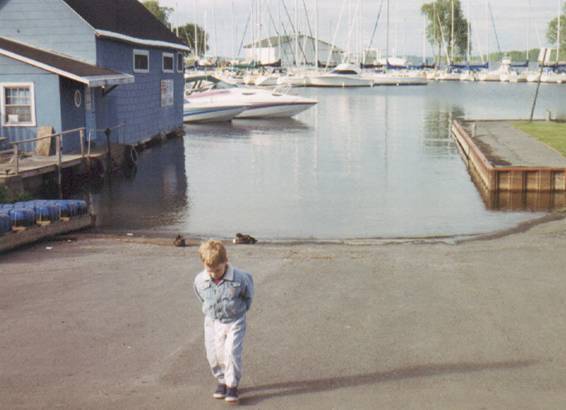
View of the water from Sackets Harbor boat launch, and one of Lewis H.
Roberts’ great-great-great-grandsons.
| BACK to Lewis H. Roberts page |
| Home |